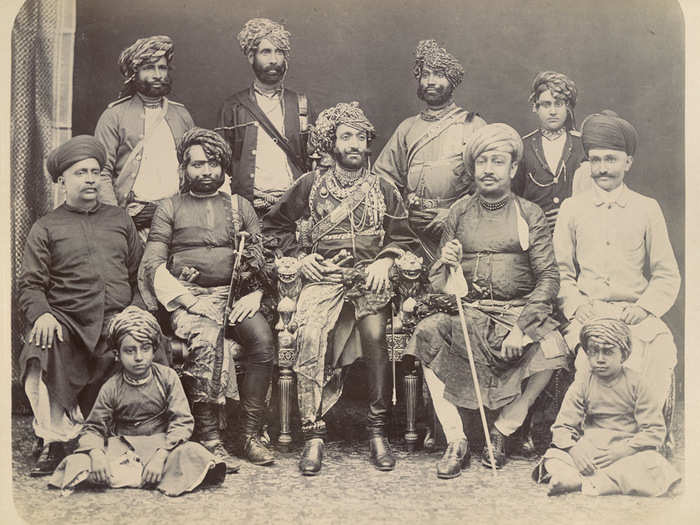This is how the Indian Government made Kings bow before them or leave for Pakistan
Junagadh

Junagadh

Patel gave Pakistan time to void the accession and hold a plebiscite in Junagadh. Samaldas Gandhi formed a democratic government-in-exile, the Arzi Hukumat (in Urdu:Arzi: People's Request, Hukumat: Government) of the people of Junagadh. Eventually, Patel ordered the forcible annexation of Junagadh's three principalities. Junagadh's court, facing financial collapse and no possibility of resisting Indian forces, first invited the Arzi Hukumat, and later the Government of India to accept the reins.
Kashmir

Maharaja Hari Singh, a Hindu, was equally hesitant about acceding to either India — he felt his mostly Muslim subjects would not like joining a Hindu-majority nation — or Pakistan — an eventuality which he would personally prefer to avoid. He personally believed that Kashmir could exercise its right to stay independent; a belief in which he was backed by Sheikh Abdullah, the leader of Kashmir's largest political party, the National Conference. However, Pakistan coveted the Himalayan kingdom, while Indian leaders including Gandhi and Nehru hoped that the kingdom would join India. Hari Singh signed a Standstill Agreement (preserving status quo) with Pakistan, but did not make his decision by August 15.
Kashmir

Patel had argued against both, describing Kashmir as a bilateral dispute and its accession as justified by international law. He had feared that the U.N.'s involvement would stall the process and allow Pakistan to reinforce its presence in Kashmir; in addition, it was far from clear, which way a plebiscite would go. In 1957, Kashmir was officially integrated into the Union, but with special provisions made for it in the Constitution's Article 370. The north-western portion that remained under control of the Pakistan army is today Pakistan-administered Kashmir. In 1962, China occupied Aksai Chin, the north-eastern region bordering Ladakh.
Hyderabad

Hyderabad was a state that stretched over 82,000 square miles (over 212,000 square kilometres) in the centre of India and with a population of 16 million, 85% of whom were Hindus. Its ruler was Nizam Usman Ali Khan, and had always enjoyed a special relationship with the British Raj. When the British ruled out dominion status, the Nizam set his mind upon independence, under the influence of Muslim radical Qasim Razvi. Without Hyderabad, a large gap would exist in the centre of the united nation envisioned by Indian nationalists and the Indian public. Patel believed that Hyderabad was looking to Pakistan for support, and could pose a constant threat to India's security in the future. Patel argued that Hyderabad was essential for India's unity, but he agreed with Lord Mountbatten that force should not be used immediately. A Standstill Agreement was signed — an agreement made with no other princely state without an explicit assurance of eventual accession. However, Patel required Hyderabad promise it would not join Pakistan. Mountbatten and India's agent K.M. Munshi engaged the Nizam's envoys into negotiations. However, no deal was reached that both sides found acceptable, and the Nizam alleged that India had created a blockade. India, on the other hand, charged that Hyderabad was receiving arms from Pakistan, and that the Nizam was allowing Razvi's Razakar militants to intimidate Hindus and attack villages in India.
Hyderabad

Lord Mountbatten crafted a proposal called the Heads of Agreement, which called for the disbandment of the Razakars and restriction of the Hyderabad army, for the Nizam to hold a plebiscite and elections for a constituent assembly, and for eventual accession. While India would control Hyderabad's foreign affairs, the deal allowed Hyderabad to set up a parallel government and delay accession. Hyderabad's envoys assured Mountbatten that the Nizam would sign the agreement, and he lobbied Patel hard to sign for India. Patel signed the deal but retained his belief that the Nizam would not accept it. The Nizam, taking Razvi's advice dismissed the plan. In September 1948, Patel made it clear in Cabinet meetings that he intended to use force against the Nizam. He obtained the agreement of the new Governor-General Chakravarthi Rajagopalachari and Prime Minister Nehru after some contentious debate, and under Operation Polo, sent the Army to invade Hyderabad. Between September 13 and 18th, Indian troops fought Hyderabadi troops and Razakars and defeated them. Patel retained the Nizam as the head of state as a conciliatory gesture. The main aim of Mountbatten and Nehru in attempting to achieve integration through diplomacy had been to avoid an outbreak of Hindu-Muslim violence. Patel insisted that if Hyderabad was allowed to continue its independence, the prestige of the Government would be tarnished and then neither Hindus nor Muslims would feel secure in its realm. The successful annexation of Hyderabad was praised by many Indian Muslim leaders, and there were no episodes of civil violence.
Popular Right Now
Popular Keywords
Advertisement